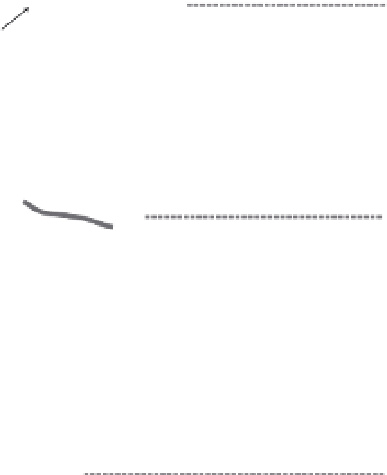Geology Reference
In-Depth Information
Glaciers, Topography, and Sediment Flux
Glacier Evolution on High Plateau Margins
A
Hillslope flux: Low
Hillslope flux:
High
Downcutting:
High
ELA
-
+
Cold-
based
ice
Mass Balance
Flow velocity
Erosion
B
Mostly
temperate
C
Distance Downstream
B
Increasing relief
Debris fan
A
ELA
Erosion
Hillslope flux:
Low
-
+
Velocity
A
Mass Balance
Debris cover
Glacial Size
Distance Downstream
C
Increasing relief
Fig. 10.54
Conceptual model for glacial-landscape
evolution on a plateau margin.
High-altitude, low-relief, and slowly eroding initial
glaciers (A) are mostly cold based. Glacial downcutting
(B) steepens glaciers, reduces the cold-based region's size,
increases relief, and increases sediment fluxes. Late-stage
glacial profiles (C) tend to be gentler and warm based.
As the glacial landscape comes toward an equilibrium, the
relief, sediment flux, and subglacial erosion rate depend
on the rock-uplift rate. Modified after Scherler
et al
. (2011).
Hillslope flux: High
ELA
Headwall
retreat
-
+
Erosion
Mass Balance
Velocity
Distance Downstream
Fig. 10.53
Glacial-topographic interactions.
Glacial velocity and debris cover are generalized from
remote sensing of glaciers on the Tibetan Plateau. Note
that the local climate is sufficiently cold that high-
altitude glaciers are cold based. A. Initial glaciers are
frozen to their beds in upper reaches and embedded in
low-relief landscapes. Erosion is focused near the toe,
and hillslope debris production is minimal. B. Erosion
beneath the lower glacier steepens the glacier, increases
topographic relief adjacent to the toe, and increases the
hillslope sediment flux and resultant supraglacial debris
in this reach. The cold-based region of the glacier
shrinks and the locus of erosion and velocity migrate
up-glacier. More of the glacier lies below the climatic
equilibrium-line altitude (ELA) but melting is greatly
reduced beneath the supraglacial debris. C. In a
mature stage, glacial erosion is focused in the headwall
area. Relief is high, especially in upper reaches.
Extensive supraglacial debris is driven by widespread,
high hillslope fluxes. Most of the glacier lies below
the ELA. Modified after Scherler
et al
. (2011).
areas are largely nourished by direct snowfall,
have little debris cover, and show a symmetrical
distribution of ice flow around the equilibrium
line (Fig. 10.53A). The upper part of such glaciers
may be frozen to their beds (cold-based), such that
erosion (most of which is subglacial) is focused
towards the glacier's toe. This erosion steepens the
glacier, gradually decreases the cold-based region
of the glacier, and increases both the relief of
adjacent peaks and the hillslope debris flux from
them, especially in the lower reaches of the glacier.
Meanwhile, the locus of erosion and the zones of
highest ice velocity shift progressively upstream,
thereby driving retreat of headwalls and a decrease
in both the mean elevation and the cold-based
fraction of the glacier. Overall, these changes in
erosion, relief, and hillslope sediments suggest a
progressive landscape evolution (Scherler
et al
.,
2011) from low- to high-relief landscape and an
increase (at least initially) in the glacial erosion
rates through time as the glacier steepens, erodes
more effectively, and transforms from cold-based
to temperate (Fig. 10.54). The final form of both
(Scherler
et al
., 2011) suggest linkages among
supraglacial debris cover, ice-flow dynamics,
glacial steepness and erosion, and landscape
characteristics. Glaciers in low-relief, high-altitude























































































































































































































































